Preamble
Before getting started, a few words about my history with the series and the way these are going to work. I first read the series in a couple of years 2012 to 2014, including reading the last few books as soon as they came out, and haven’t reread them since. In this reread and analysis, I might read ahead a bit, but mainly I’m going to focus on the content of each chapter as I get to it. As such, whilst I might refer to events further ahead in the series, it does rather rely on me remembering them, so I suspect it will be at a minimum.
That said, I do not consider this a spoiler-free zone. Caveat lector.
I’m going to try to follow this basic structure, at least to begin with: a summary of the chapter, paying special attention to the introduction of new characters, kinden, places and polities; political analysis, which as I go along will hopefully, increasingly, tie the individual chapters into the larger politics of the series; and historical analysis, discussing parallels and references of various kinds, sometimes with a focus on specific topics (like education or food). A regular part of the historical analysis will be a military history corner, on which more below.
All of this is of course subject to change as I go along and continue to figure out what works. Suggestions on things I should talk about or adjustments in format are welcome!
Summary
‘You yourself have other means, Sten. You must go back to your college and your clever, machine-fingered people, and have them make ready. Of all of us, you were always the real hope of the future.’ (19)
The Shadows of the Apt series opens in media res, with a battle for the city of Myna, showing the threat of the expanding Wasp Empire. We meet Stenwold and a few other characters who aren’t locals, who make an escape by air as the city falls, with some of them dying on the way.
Character introductions
What a band we are. The thought passed through Stenwold’s mind as he took the stairs, bringing up the rear as always. (5)

Tchaikovsky’s fantasy casting of Stenwold is apparently Lawrence Fishburn, which seems pretty spot on.
Stenwold Maker. The very first character we meet, Stenwold opens the series looking through a telescope, befitting his nature as artificer but even more so as observer. I actually forgot until most of the way through the chapter that it takes place over a decade before the rest of the series, but I like that we get to see a younger Stenwold here. He’s shown to be quick-thinking and analytical, compassionate but also pragmatic, and seeing things through his eyes begins to orient us to some of the less accessible characters. Stenwold is described as ‘dark of skin and receding of hair, stout and bulky, loud of tread,’ (6) and is dressed for machining rather than war. In fact, he seems at first to be a bit of a hindrance to his gang’s escape, tripping over and fumbling with his crossbow. Once they get to the airfield, however, he is able to play to his strengths, piloting an air craft he’s never seen before, killing for the first time, and rescuing his friend Tisamon from self-destruction by Wasp-kinden by sheer stubborness. We also get a sense of the source of his single-mindedness thereafter about preventing Wasp invasion of the lowlands: not only has he seen a city fall to them first-hand, but he knows they have much further-reaching plans:
That one glimpse he had caught, of the Wasps’ great map, had been a harsh education. A map of lands he had never seen, extending down to lands he knew all too well […] A map of a projected conquest that stopped only with the Wasps’ knowledge of their world.
‘Nobody will care,’ Tisamon repeated, and there was a rare wisdom in his voice. ‘What is the Lowlands, anyway? A half-dozen feuding city-states […] and perhaps a few men like yourself, trying to make sense of it all. The Wasps are a unity, we are a motley.’ (18)
I love this passage because it reminds me of Stenwold’s ability to think in terms of the big picture, and particularly to hope for unity in diversity. Already we’ve encountered his tendency to surround himself by different kinden (I think he’s the only Beetle kinden we meet in this chapter, although Myna is a Soldier Beetle city), and to make friends with people who are very different to him and often oddballs in their own right. Tisamon describes the Lowlands as a motley, but while I don’t think Stenwold would disagree, I think he sees that as a positive in itself and a potential strength. In this he is very much a product of his hometown, Collegium, as I’ll return to below.
Marius and the renegade Ants of Sarn. Marius is an Ant, leader of a squadron who almost all die with him in the escape from the city, but I think he’s interesting anyway, not least in giving us more information about Stenwold. Marius is calm and contained, leading a troop who move with ‘single purpose’ (7) and who sacrifice themselves to guard the band’s retreat. But what’s so great is that as much as he and his troop seem reserved and singular to Stenwold, they’re individualists as far as Ants go, deserters from a city they know they cannot return to. Stenwold sees their leader as trying to act, like himself, in the service of the bigger picture: ‘Marius only left because he thought this was for your people’s own good.’ (17) But upon rereading, it’s clear it’s also a choice founded in loyalty to and faith in Stenwold himself:
‘He says he regrets that things have ended this way, and he also regrets that the others, Atryssa and Nero, were not with us, but he does not regret following you from his city, and he does not regret dying in this company.’ (17)
This is the first time in the series we see people sacrifice themselves for Stenwold’s vision, but it’s far from the last. It shows the respect he inspires in soldiers, and we also get our first ‘good death,’ a fantasy trope I think the series does really well.
Tisamon. If Marius is a soldier, Tisamon is a quintessential and iconic lone warrior, full of blood-lust and ‘clinging to his grudges and his honour like a drowning man.’ (6) The Mantis-kinden are Inapt and seen by Stenwold as belonging to a bygone era, but
[t]hey were matchless, whether in single duel or a skirmish of swords, and Tisamon was a master, the deadliest fighter Stenwold had ever known. (2)
Tisamon is described as ‘tall and pale,’ (2) ‘lean’, (9) ‘the most graceful man Stenwold had ever known.’ (5) He doesn’t fight, he dances. Though he and the Beetle seem to have a long history between them, it’s clear that when he’s angry, even Stenwold finds him a bit scary. The reason he’s so upset is that he thinks they’ve been betrayed by his lover Atryssa, which is compounded because the Spider-kinden are ancient enemies of the Mantises. Tisamon is a Romantic; he’s angry and suicidal because he’s been hurt by a lover he trusted despite that ingrained history. He clearly loves Stenwold deeply, too; in spite of their slightly combative dynamic, there’s a fondness even in the way he calls him ‘fat-Beetle’, (9) and he’s deeply reliant on the artificer to navigate even basic technology. (Check out the way this fast-moving killing machine is stopped in his tracks and looks to Stenwold for help when confronted by a door handle. Moments like that are why I love this deeply ridiculous conceit of Aptitude.)
Tisamon might be all about honour and even, in the form of Weaponmaster, belong to his own special league of murder ninjas, but (unsurprisingly for a friend of Stenwold’s), he’s not totally bound by tradition. He seems pretty frustrated by the insularity of Mantis-kinden – ‘They have quarrels a thousand years old that they have yet to settle’ (17) – and yet aware that he himself is limited by their culture. We learn that he has been living in Collegium with Stenwold, but does not feel he belongs there:
‘No debate and diplomacy. No society. No kind words, ever again. […] I will stay at Helleron and I will oppose the Wasps the only way I can.’ (18-19)
Tisamon has apparently been trying to live in a way untypical for Mantis-kinden, but at the opening of the story, he gives up on that for some angsty knight-erranting.
Political analysis
There is little directly political plot happening in this chapter, but there are some interesting hints at how the insect-kinden structure their societies. Although the kinden have (apparently?) biological differences in terms of their Arts (for example, Mantises have spines on their arms, and Wasps can fly and shoot ‘stings’ from their hands), it’s clear that Tchaikovsky is interested in using them to explore ideas of culture and identity as much as ‘hey, wouldn’t it be cool if people had insect skillz’ (though it is pretty cool).
As mentioned, the Lowlands are a region made up of ‘a half-dozen feuding city-states’, and different cities (even of the same or related kinden, such as Collegium and Myna) are not politically integrated. Stenwold’s hope seems to be that the different cultures and polities will be able to co-operate in some way to fight the Wasp Empire, and though he isn’t explicit about the form this should take, he’s almost certainly thinking more along the lines of information sharing and broad military alliance than uniting under a single government.
Beetles are, at least to start with, largely presented to us as the ‘default’ race in the series. Although we hear that Beetles are ‘heavy-boned’ (6) and not natural fighters, we get a reasonably positive picture of them in this chapter:
Stenwold was Beetle-kinden and in the Lowlands his people were known for their industry, their artifice, even, as he liked to think, for their charity and kindly philosophy. (8)
The tiered, walled city of Myna is inhabited by ‘some offshoot of Beetle stock’ (8) (it’s later revealed that they’re Soldier Beetles), and they have their own artificers and airfield. We don’t learn anything about its form of government, though it apparently has an organised army, ‘a disciplined lot’ (5) with something of a uniform (‘black and red armour’, 3). In addition, the citizens of Myna are themselves armed and ready to fight:
Men and women, and boys and girls still too young to be here at all, they were clutching knives and swords and staves, and waiting. […] All around now, they were brandishing their swords or workman’s hammers or simple wooden clubs. (6-7)
What they are notably not brandishing are axes or farm tools, suggesting perhaps that unrepresented among them are peasants from the surrounding area who have fled inside the walls for protection. We learn that Myna certainly does have ‘tributary settlements’ of this kind (17), but not what has happened to the people living in them. Maybe the silence on this is simply a reflection of Stenwold’s bias as a city-dweller and skilled workman of sorts himself.
We’re also introduced to one more Beetle city:
‘We tried to warn your people at Helleron that the Wasps are coming, and what did they say? That nobody would invade Helleron. They claimed that the city was too useful. That Wasps needed to trade and deal in arms just like everyone else. They look upon the Empire as just another Ant city-state.’ (17)
As reflected in Stenwold’s own mindset and the company he keeps, Beetles seem to be relatively outward looking and culturally open, not afraid of contact with new peoples. In Helleron at least, they’re manufacturers and traders who see the world as interconnected and assume they can rely on self-interest, pragmatism and mutual advantage to keep things ticking along. Wars may come and go, but Beetles are successful and adaptable enough to profit off them. To me this complacency suggests a relatively stable political status quo, at least as it pertains to them; they’re not fighting in these wars themselves.
If Beetles are moderately cosmopolitan, Ants are far less so (though evidently Beetle and Ant city-states are somewhat familiar with each other and engaged in trade). They have an organised military outlook, and a culture of conformity linked in some way to their ability to communicate telepathically with each other (it’s not clear whether this leads to their insularity, results from it, or both). Even their appearance is uniform: they’re ‘universally compact’, dressed alike, and look similar enough ‘to be family’. (5, 1) Though Marius is Stenwold’s friend, the other Ants keep to themselves (‘Stenwold realized that he knew none of their names, had not even heard many of them speak,’ 12), and Stenwold finds them impassive and somewhat alien:
Ant-kinden, he would never understand them or their communal world. Or how Marius had managed to leave that world and not look back. (12)
We learn that there are multiple Ant city-states; they are seemingly somewhat hidebound, but not homogenous or politically static:
‘But Marius – Sarn isn’t like the other Ant cities any more. There have been changes. There are even some of my own kin on the council there,’ Stenwold insisted. (17)
Nonetheless, Marius and his unnamed female soldier insist that, having gone renegade, they cannot return. They are not unique amongst Ant-kinden; it is apparently common enough for there to be a tradition of Ant renegades turning mercenary in Helleron. (18) Crucially, the Ant cities might be organised and efficient, but they are also unable to accept the Wasp threat.
It’s in relation to the Mantis-kinden that we learn that some kind of revolution in the distant past (Stenwold thinks of it as the Bad Old Days, 15) led to a vast overhaul of the power structure in the Lowlands. Mantises were powerful in the past but are now technologically, socially and politically outpaced (which I guess they would be, once levers have been invented); yet ‘[e]ven though their time of greatness had passed, they were still not to be toyed with.’ (2) The main strength of the Mantis-kinden, as represented by Tisamon, seems to be martial (though not really military – Tisamon fights alone), and these days they are apparently an inward-looking people.
We hear about Spiders only through other characters’ opinions of Atryssa. All we learn about them thus far is the stereotype, which her actions seem to confirm, that they are ‘subtle and devious’, and that there are ‘a thousand years of race-hatred’ between them and the Mantises. (4) Stenwold has been working with the artificers of Myna to establish some kind of last-ditch defence of the city, using gunpowder; when the plan doesn’t come off, Stenwold and Tisamon assume that Atryssa has betrayed it to the Wasps to enable their victory, though why she might want this is not clear.
‘Who else knew the plan? Or do you think the people of Myna have sold their own to the slavers’ block?’ (4)
The ‘dream of a black-and-gold world’ (7)
What we learn about Wasps, here, is similarly inflected by our external point of view: they are definitively othered, portrayed as both a highly organised army and a savage horde. They are described as consisting of well-equipped divisions with different strengths, and led tactically enough to have a vanguard, come in multiple waves, and seek out specific targets like the airfield; yet they are simultaneously a ‘glittering mob,’ (3) ‘a frenzied mass of hatred, out solely for slaughter.’ (8) I think part of this mismatch is simply Stenwold misunderstanding the military culture and political aims of the Wasps. For instance, he claims,
If the Wasps had been arrayed in military order they could have swept the place clean in a minute, but they were mad for blood, each one on their own. (10)
The Wasps are definitely not all out for themselves; as I’ve said, their army shows evidence of hierarchy, organisation and direction. But they’re also not interested in ‘sweeping the place clean’: their goal is to take over the city and integrate it into their empire, not to raze it to the ground. For this they need to establish control of key locations, not kill everyone they meet. At the same time, as we will learn, part of establishing control for the Wasp Empire is the spreading of terror – and furthermore, in a society that venerates ultra-violent masculinity, brutality against civilians is not looked upon negatively or seen as dishonourable.
Unlike Marius’ troops, who ‘fought beautifully’ (12), or Tisamon, ‘the most graceful man Stenwold had ever known,’ the Wasps are not portrayed as exceptional fighters. What we do know is that they come from an expansionist state, they are a relentless military force (‘It would not be quick or easy to capture this city, but the Wasps would have it in the end,’ 7) and they are numerous. ‘Their army had five men for every defender the city could muster.’ (5) Stenwold has seen their map, and he’s pretty sure they want to take over the world.
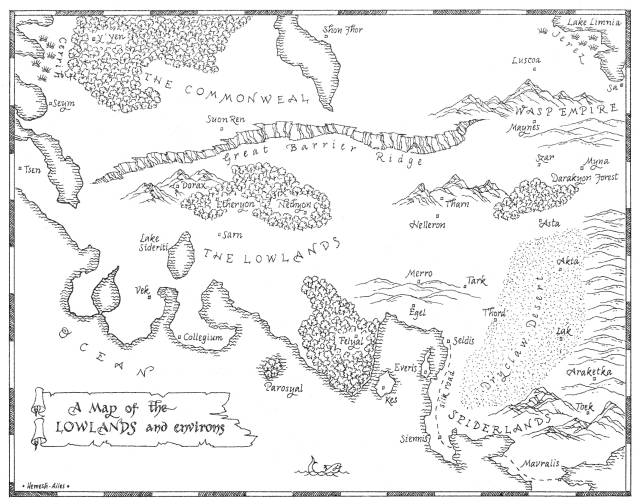
Hemesh Alles’ map from Book 1. Not pictured: Wasp ‘lines of advance and supply.’ (18)
To me, the projected Wasp Empire resembles Wallerstein’s idea of a ‘world-empire’, about which he says:
Note the hyphen […] Putting in the hyphen was intended to underline that we are talking not about systems, economies, empires of the (whole) world, but about systems, economies, empires that are a world (but quite possibly, and indeed usually, not encompassing the entire globe). […] In “world-systems” we are dealing with a spatial/temporal zone which cuts across many political and cultural units, one that represents an integrated zone of activity and institutions which obey certain systemic rules. [1]
A world-empire (such as the Roman Empire, Han China) is a large bureaucratic structure with a single political center [sic] and an axial division of labour, but multiple cultures. [2]
I’m sure I’ll return to this idea in the future, but for now I just wanted to note that the political structure of the Wasps is of a completely different kind to that of the city states and ancient civilisations of the Lowlands, and it has different aims.
The positioning of the Wasps as ambivalently civilised is mirrored in their developing but still primitive (in Stenwold’s eyes) technology:
It was ugly as sin and it hung in the air as elegantly as a hanged man, but nevertheless it stayed up and there had to be some craft in that feat. A heliopter in Wasp colours, a monstrous, uneven metal box with three spinning blades straining to keep it from crashing to the ground. There must have been hatches in its underbelly, he realised, because here was a stream of missiles falling constantly from it onto Myna. He thought they were rocks at first but, on seeing the explosions, decided they must be firepots or firepowder grenades. […]
[T]hat was a crude and primitive piece. Any self-respecting artificer would have been rightly ashamed of it. And yet it flew, and only five years ago the Wasps had possessed nothing like it. (15-16)
So, the Wasps are Apt and are quickly developing aviation technology, though they are perhaps not yet highly advanced; they are a sophisticated though inhumane fighting force; they come from outside the Lowlands, and they seem to know of a wider world than do the Lowlanders. Oh, and they want to conquer EVERYTHING.
‘We have to leave now,’ Stenwold said, ‘or we’ll never get out. Someone has to know what’s happened here. The Lowlands have to be warned.’
‘The Lowlands won’t care,’ said Marius… (5)
Historical analysis
Military technology corner
One of the dumbest things about starting this project is that I know almost nothing about the history of military technology. Not only is this something that Tchaikovsky is clearly quite interested in from a character and world-building point of view, in part perhaps because he’s a stage fighter and LARPer himself, but its development is central to the political plots. This dynamism is part of what makes the battles in the series so excellent, but it also means I’ll be constantly scrambling to catch up and learn about new stuff. Please bear with me, and if you have suggestions of reference or background works, they will be very gratefully received. [3]
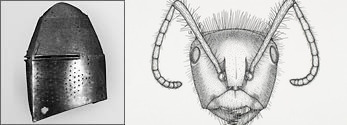
Pembridge great helm, mid-14th century, and ant head drawn by Ladina Ribi. I can kind of imagine the congruence between the two. It’s something about their flat-face-iness.
Let’s get into it. In this chapter, there’s mention of several weapons and armour types. To my extremely untutored eye, much of it does at this stage seem to be roughly clustered in Europe and Asia around the High to Late Middle Ages (i.e. classic high fantasy technology) – for example, Marius and co’s great helms (1), Tisamon’s leather arming jacket (5), or Myna’s use of ballista (3) – but there are obvious exceptions.
On the one hand, the use of gunpowder is not at all anachronistic for this time period – its military use had spread across Eurasia by the 13-14th centuries – but for some reason doesn’t seem to make it into most medieval-ish fantasy. In Shadows of the Apt, it’s certainly in use amongst the Apt, though sometimes in ways I can’t think of historical parallels for:
All that time he had spent with the artificers of Myna, charging the earth in front of the gates with powder, and nothing. (3)
Some kind of large-surface-area land mine, maybe? I’m not sure, though given that it doesn’t go off, perhaps it’s a technological dead-end for the Apt anyway.
On the other hand, we have flying machines. There’ll be plenty of time for me to get into the history of aviation… but it’s safe to say that no one in the Middle Ages had anything like the metal heliopter of the Wasps or the steam-powered orthopter flown by Stenwold. I’m not sure anyone has ever had anything quite like them.
Overall, the weaponry in Chapter One is a remix of successful military technology from different time periods along with some imagined developments of paths not taken (see: aircraft with flapping wings).
The Weaponmaster
The hardest piece of military technology for me to understand in a casual reading of this chapter was Tisamon’s bladed glove, so my main focus in this ‘Military technology corner’ will be possible historical inspirations for this metal mantis claw with a two-foot edge. (11)
First, here are the main descriptions of it, which I have read perhaps 50 times at this point:
He wore his armoured glove, with the blade jutting out from between the fingers, flexing out like a sword blade one moment, folded back along his arm the next. It was an ancient tool of his kind and a laughable anachronism, save that Stenwold had witnessed what he could do with it. (7)
The Mantis was hinging his metal claw forward and back, rolling his fingers about the crosspiece to lay the blade flat against his arm, then bringing it out to jut forward from his knuckles. (18)
If you’re having trouble visualising this, then I recommend looking at some images of actual mantis legs, something I wish I’d thought to do far sooner.
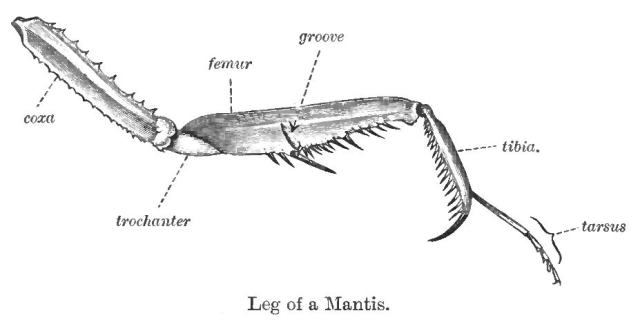
Image from Guide to the exhibited series of insects in the Department of Zoology, British Museum (Nat. Hist.) (London, 1909), p.19. If you’re still confused, I recommend looking at photos of mantises; I found them easier to understand, but this is at least conveniently labelled.
Tisamon has spines on his forearm from his Mantis-Art; if he were a mantis, I think that would correspond to the femur. His claw takes the place of the mantis tibia in the diagram above, which folds in and out along the forearm (though presumably along the inner forearm, not on top of the spikes as it is for actual mantises). The weapon is buckled onto his hand so he can flex it back and forth with his fingers.
So, did anyone ever use a weapon like this?
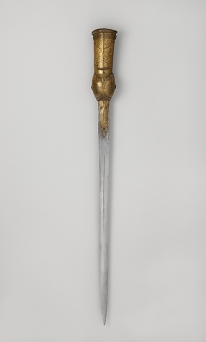
Pata with early 18th century hilt and 16th century blade, from the Met Museum.
Not exactly, but there are some definite parallels, usefully discussed (with several discarded) in the comments on this post. The claw seems to be somewhat akin to the Indian pata or (dand)patta, a gauntlet sword used in the 16th and 17th century, especially though not solely in the Maratha Empire. Though images abound, writing in English on the pata is scarce and somewhat contradictory; for example, some sources I looked at (including Stone) describe it as only used by cavalry, whereas others emphasise its usefulness against cavalry. Some see it as a punch blade, evolved perhaps from the katar, a push-dagger with a similar crossbar hilt, whereas others describe its use for slashing – check out this video of a man showing off some skills to get an idea of how Tisamon’s spinning, leaping, slashing style of fighting, described in this chapter, might look. There are a few mentions, though, of the pata’s power (so long as one had strong forearms!), and of how highly trained one needed to be to use it. That seems about right for Tisamon. The main difference between the pata and the mantis claw is that the blade is not hinged and cannot be folded back along the arm in the same way. [4]
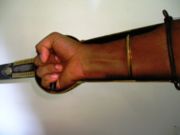
You hold a pata like this.
Later in the chapter, the Mantis unbuckles his gauntlet, switching to a greatbow:
Tisamon had opened his case and was stringing his greatbow. […Stenwold] would not have swapped such a bow in Tisamon’s hands for the latest repeating crossbow. (15)
As I understand it, the greatbow is basically akin to the longbow: a self-bow (i.e., made only out of wood, with the woods of choice often being yew or elm) as tall as the person shooting it, and held vertically, rather than horizontally like a crossbow.
Loades describes the appeal of the longbow as in part romantic: in the medieval period, it allowed men without much wealth or status to take down knights with their sheer strength and skill. [5] Its association with use in difficult terrain such as forests, and by folk heroes such as Robin Hood, combine to make it a great weapon for Tisamon, a wanderer if not (yet) an outlaw whose people’s most sacred places are found in the woods. Although longbows of some form had been in use for a long time before this and across much of the world, they came to prominence and are most frequently imagined in their medieval incarnation, as a weapon used in large numbers in English armies from the 13th to the early 16th centuries. It was crucial at battles such as Crécy and Agincourt during the Hundred Years War. Archers in these battles were also likely to be capable light infantrymen, so Tisamon’s switching between these weapons as required has a certain historical resonance.

Even though the historiography focuses on English/Northern European longbows, functionally identical weapons existed elsewhere. This wooden bow, nearly two metres tall, was acquired from Sri Lanka in the 19th century. British Museum, As.220.
Much of our knowledge of medieval longbows comes from the 150+ bows salvaged from the wreck of the Mary Rose, a warship sunk in 1545 and excavated between 1979 and 1982. [6] Longbows seem to have remained in use in naval battles even after they became less common in pitched battles on land; their firing speed, imperviousness to water, and the user’s ability to correct for a vessel’s movement made them preferable at sea to guns. One can imagine similar advantages when firing from an airship, as Tisamon does in this chapter.
Longbows were also effective against all kinds of armour. According to Strickland, when using a longbow, ‘[b]odkin-headed arrows could easily pierce mail, and though further ballistic tests are necessary, it seems certain that at closer range some forms of plate armour could be penetrated.’ [7] A weapon used over an extremely long period without drastic changes in design, and effective against more recent weapons and armour, is obviously fitting for a people as poor at technological innovation as the Mantises.
Stenwold is therefore perfectly justified in seeing ‘such a bow in Tisamon’s hands’ as superior to the repeating crossbow. Where wood and skilled men were readily available, the advantages of the longbow remained real until at least the fifteenth century: they were quicker to reload than a crossbow, cheap and easy to produce, and in the right hands were extremely powerful, long-ranging and accurate. In England between the 14th and 16th century, there were numerous laws attempting to enforce regular practice for men and boys so that they would be useful in case of war. [8] An ancient weapon requiring strength, skill and years of frequent training certainly seems fitting for what we know of the Mantis-kinden, but these were also the reasons they passed out of common use both in our world and that of the series. It was simply much easier for the non-expert to operate a crossbow and then a musket, a factor in the development of weaponry that Tchaikovsky makes perfectly clear as large-scale mobilisation becomes increasingly important for the Insect-kinden.
Page references within the text refer to the 2012 Tor edition of Empire in Black and Gold.
Footnotes
[1] Immanuel Wallerstein, World-Systems Analysis: An Introduction (Durham, 2004), pp.16-17.
[2] Ibid., p.99.
[3] Throughout this section, I’ve used two main reference books in addition to the other works cited: James C. Bradford (ed.), International Encyclopedia of Military History (Abingdon, 2006) and Richard Holmes (ed.), The Oxford Companion to Military History (Oxford, 2001).
[4] George Cameron Stone, A Glossary of the Construction, Decoration and Use of Arms and Armor in All Countries and in All Times, Together with Some Closely Related Subjects (New York, 1999 [1934]), pp.484-7; Navina Najat Haidar and Marika Sardar, Sultans of Deccan India, 1500-1700: Opulence and Fantasy (London, 2015), pp.91-2.
[5] Mike Loades, The Longbow (Oxford, 2013), p.4. The other works I relied on for the following were Jim Bradbury, The Medieval Archer (Woodbridge, Suffolk, 1985); and Robert Hardy, Longbow: A Social and Military History (Yeovil, Somerset, 2010), 4th edition. I also had a quick scope out of Kaushik Roy, Hinduism and the Ethics of Warfare in South Asia: From Antiquity to the Present (Cambridge, 2012), to clarify that yes, tall wooden self-bows were in use in early modern South Asia (though Muslim armies were more likely to consist of horse archers using composite bows).
[6] I learned quite a lot from this video about the Mary Rose longbows, ‘Examining an English longbow,’ from the University of Southampton, accessed at futurelearn.com/courses/agincourt/0/steps/8846.
[7] Matthew Strickland, ‘Bows’, in Holmes (ed.), The Oxford Companion to Military History, p.145.
[8] Loades, The Longbow, pp.26-30.
If you would like to discuss this chapter or any of the points I’ve raised here further, please do leave a comment!